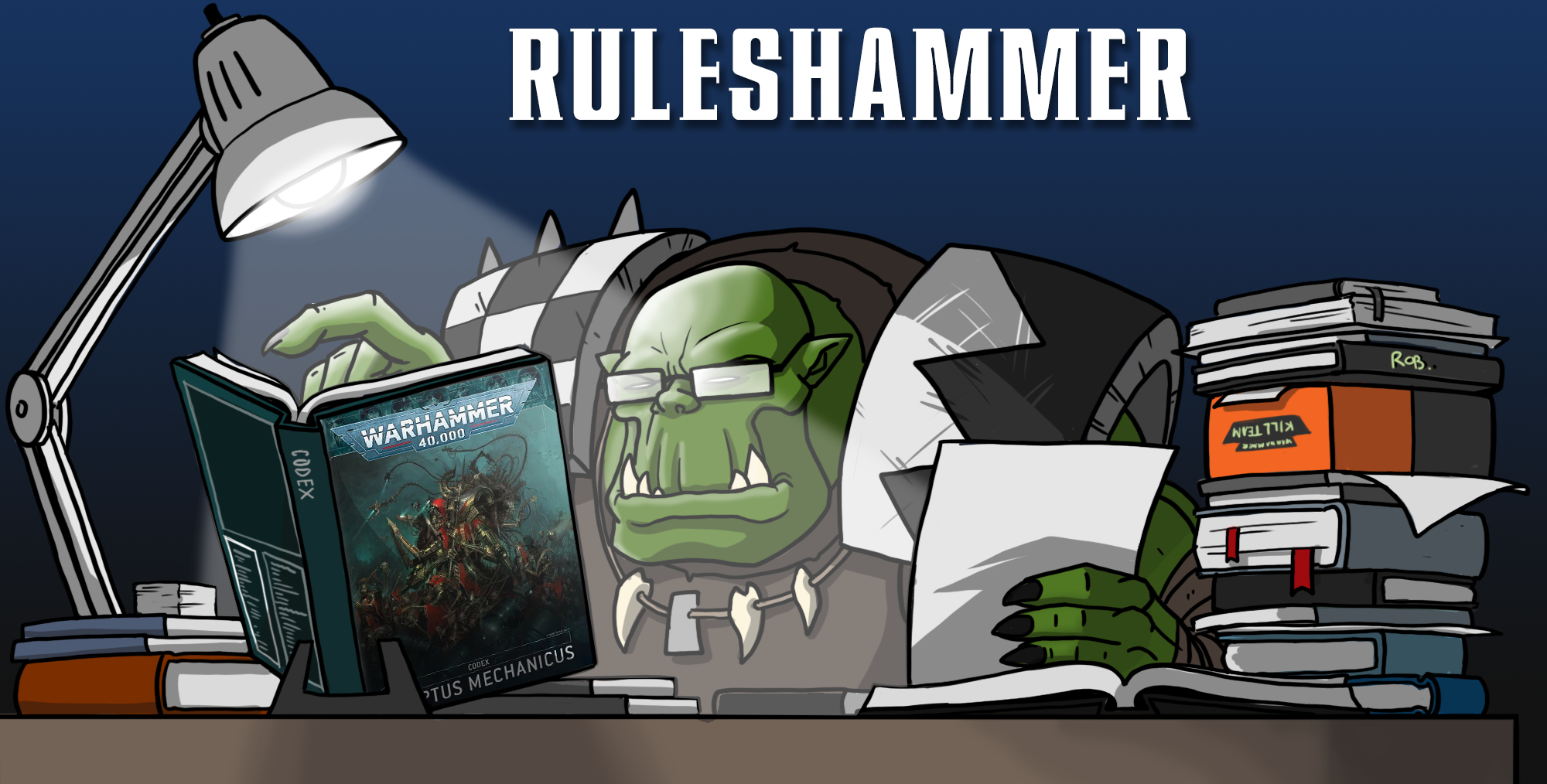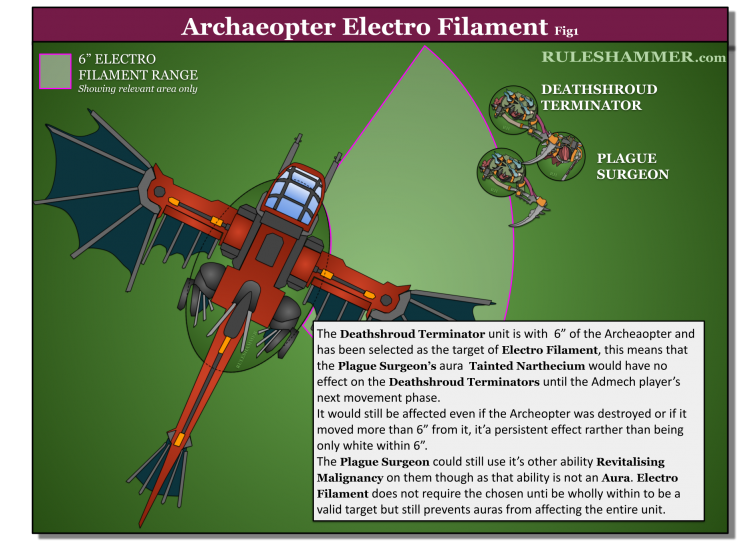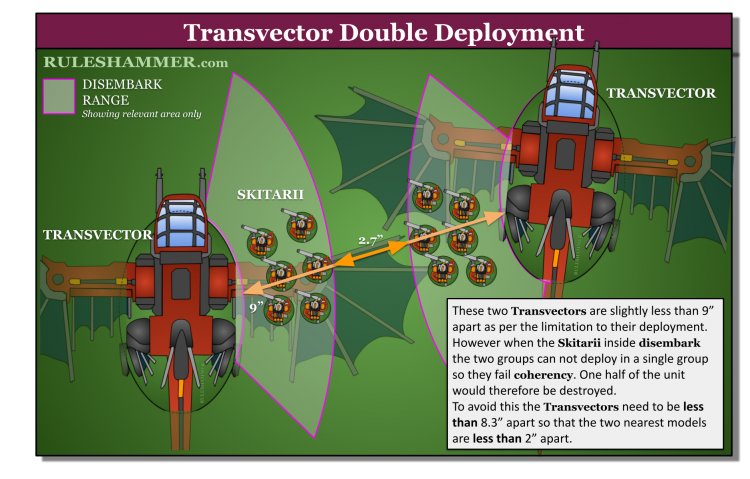Welcome to Ruleshammer Codex Adeptus Mechanicus – the one place to look for Ruleshammer Q&A on Admech issues!
Last updated 2022-02-04
Current Q&A
What the heck is a relic?
I’d usually edit down questions but really this one has done so much of the explanation and work for us already, I’m going to share the whole thing.
Q: Here’s a fun one. AdMech have a codex secondary (Accretion of Knowledge) that rewards you for destroying models that meet certain criteria – one of which is “the model has a Relic”. What is a Relic?
Four examples where it’s less than 100% obvious, in increasing order of difficulty.
1. Orks have Shiny Gubbinz, not Relics. The codex says “If your army is led by an ORKS WARLORD, you can, when mustering your army, give one of the following Shiny Gubbinz to an ORKS CHARACTER model in your army.” However, the very next sentence is “Named characters cannot be given any of the following Relics”, very clearly implying that Shiny Gubbinz are Relics by another name.
2. T’au have Signature Systems, not Relics. They’re extremely clearly relic-replacements – they have the same rules for granting them, the strat for extra ones, yadda yadda yadda, so the RAI seems pretty clear. But the word “relic” doesn’t appear anywhere in Codex: T’au Empire…
3. T’au also have Prototype Weapons Systems. If a Signature System is a relic by proxy, then should something you can take in place of a Signature System also qualify as such? Certainly, an Amplified Ion Accelerator on a Riptide, or Cross-Linked Stabiliser Jets on a Commander, look an awful lot like relics. And you get more of them by using the strat for extra Signature Systems. But give the Gatling Burst Cannon upgrade to a unit of five Crisis suits, and suddenly they give up 15VP all by themselves if these count as relics!
3, Complicating the above two cases, T’au’s Psychic Awakening book included Enclave Relics. “If your army is led by a Farsight Enclaves Warlord, you can give one of the following Enclave Relics to a Farsight Enclaves CHARACTER model from your army instead of giving them a Signature System from Codex: T’au Empire.” Clearly, these are relics. They can be given out instead of Signature Systems, which bolsters the case that Signature Systems are relics. But it ALSO bolsters the case that PWSs are relics…
4. The new Black Templars have Relic Bearers – upgrades that you buy with points and give to arbitrary models, not just characters. In the “yes, these are relics” corner – it’s in a rules section entitled “RELIC BEARERS”, taking one of these upgrades also gives the model’s unit the RELIC BEARERS keyword, and the upgrades themselves are listed in a table where the names of the upgrades are in a column headed “RELIC”. In the “no, these aren’t relics” corner – the actual rules section itself never uses the word “relic”, carefully referring to them as “upgrades” in every single instance. And in game design terms, these are clearly BT’s equivalent of GK’s Visions/Gifts, or Orks’ Kustom Jobs, or TSons’ Legion Command upgrades, none of which anyone would consider “relics”. My personal stance here is “no, they don’t count” – those “no” arguments convey intent more clearly than the “yes” ones in my view – but it’s so unintuitive to try to argue that a RELIC BEARER is not bearing a Relic
– Chris Paterson
So yeah essentially I think you’re correct and we probably can all agree that a relic is any wargear conveyed via the “if your warlord is X you can give Y from this list” mechanics. It’s 100% a thing Admech players might want to make clear pregame. I think you’ve identified two areas I’d like to highlight further.
- Relics probably shouldn’t include wargear given to many models in place of giving a “Relic” to a character as normal. So this would rule out Tau’s Prototype weapons systems but I would completely agree that Signature Systems are Relics.
- It shouldn’t include GW being lazy with the word Relic. So I completely agree about Black Templars Relic Bearers not counting either.
This isn’t the first time GW have written rules using Relic as if it’s a catch-all term as far as I know, it’s a bit of a shame that none of the glossaries define the factions special terms for these are being equivalent. One thing worth mentioning is that so far all of the 9th Edition books have managed to have a page with the title Relics where their relics are lists, though with some flavorful text still such as in the Orks codex.
Kataphrons and their move through Terrain Rule
One of the largest changes in the Codex: Adeptus Mechanicus from 8th edition is that Kataphrons are no longer INFANTRY (my campaigning to amend this injustice against Tau Broadsides evidently worked), but to compensate the unit received a new rule to give them part of what the INFANFTRY keyword usually provides:
Tracked Mobility: Models in this unit can move through the walls, girders, chains and foliage of terrain features with the Breachable terrain trait (see the Warhammer 40,000 Core book) without impediment.
The key difference this has over Infantry is that they lose the abilities afforded by the Scalable Terrain trait, so they can no longer climb to the upper floors or a ruin or move through ceilings/floors.
Other than the slightly more restricted movement losing Infantry also prevents Kataphrons from gaining Light or Heavy cover from terrain and they are no longer affected by the Heavy Weapon penalty.
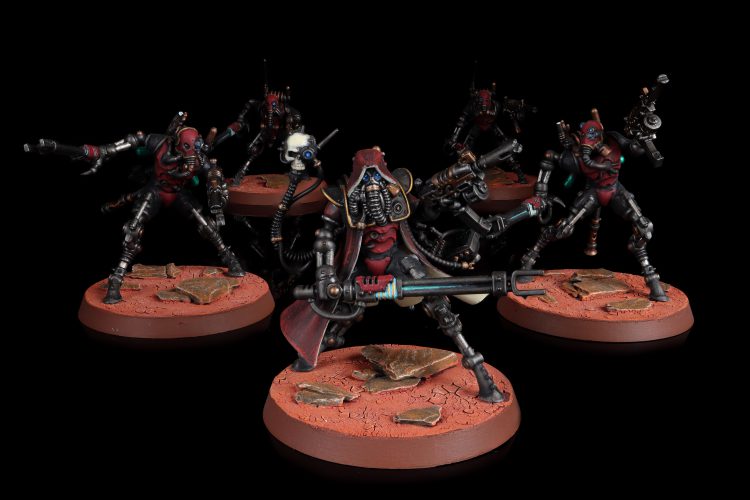
Credit: Pendulin
Using the FOUR Doctrina Imperatives
Savvy Admech Codex readers will notice that there are four Doctrina Imperatives and that the game has five battle rounds. Using imperatives is an optional choice at the start of each round (more on that later).
At the start of the battle round, if there is a Doctrina Assembler model from your army on the battlefield, you can select one Doctrina Imperative that has not yet been active for your army. If you do so, until the end of the battle round, that Doctrina Imperative is active for your army.
So you can decide which battle rounds you are going to be use them in and will always have one one round where there’s none. Take note though; these abilities are per round. You don’t decide in your command phase you decide at the start of each round. If you are going second you can still decide to have an Imperative active for that entire round, something to remember when one of them improves saves by 1. Most admech players will be used to this though, as it’s the same as Canticles in the old codex which continue to function this way.
What happens if I forget to choose a Doctrina Imperative or Canticle for the turn?
This will depend on the setting of the game I guess. In a competitive setting I’d imagine most players and judges would expect you, as the Admech player, to be sure you are remembering to use your rules. In more casual settings I could see some players letting you fix such errors especially as the book is new. One thing I would seriously suggest with a codex of this many layers is to prepare a system to remember them, a small crib sheet of abilities your army uses.
The Electro Filament Strat
The Electro Filament Stratagem changed pretty drastically in mechanics from its 8th edition incarnation to achieve a similar effect.
Use this stratagem at the end of your Movement Phase. Select one ARCHAEOPTER model in your army that is equipped with a command uplink and one enemy unit within 6” of that model. Until the start of your next Movement phase, that enemy unit is not affected by Aura abilities of other enemy units.
Compared to the previous version of the rule it’s significant.
Use this Stratagem at the end of your Movement phase. Select one ARCHAEOPTER unit equipped with a command uplink from your army. Until the start of your next turn, enemy models aura abilities have no effect whilst within 6″ of that unit.
First things first, the new ability does not create an Aura around the ARCHAEOPTER like the old one, It continues to affect the chosen unit until the Admech player’s next movement phase and it now only affects a single unit rather than all units within 6”. The second big change is that instead of causing the aura abilities models have from having no effect, it now prevents the chosen unit from benefiting from aura abilities. Lets see how this looks on the battlefield.
Archeopter Electro Filament Example Diagrams

Double Transvector Disembarkment
Probably the wackiest rule in the codex, the ability to field two Transvectors as a single transport with capacity 12 has some quirks when it comes to disembarking. Specifically these two parts:
Make a note of which infantry models are embarked within which TRANSPORT models.
So the models are still considered to be in two different individual models which makes the next part easier to understand but also slightly baffling.
When those two TRANSPORT models are setup, they must be set up within 9” of one another, and any disembarking units must follow the normal rules for disembarking transports and coherency.
The 9” here is the oddity, if you put these two models 9” apart then it becomes impossible to disembark the unit between them and have that unit be in coherency.
A unit that has more than one model must be set up and finish any sort of move as a single group, with all models within 2″ horizontally and 5″ vertically of at least one other model from their unit. While a unit has six or more models, all models must instead be within 2″ horizontally and 5″ vertically of at least two other models from their unit. This is called unit coherency. If a unit cannot end any kind of move in unit coherency, that move cannot be made. Units are primarily moved in the Movement phase (pg 10), but they can also be moved in the Charge phase (pg 19) and the Fight phase (pg 21).
Q Some rules allow you to add models to a unit during the battle; such models must always be set up in unit coherency with the unit they are being added to. Sometimes there will be insufficient room to set up all the models from a unit, or it will not be possible to set up all the models so that they are in unit coherency. When this is the case, any models that cannot be set up are considered to have been destroyed.
Transvector Double Deployment Example Diagram

Seismic Bomb Stratagem and Rounding 40k
This stratagem has you halve two different things.
- Halve the Move characteristic of models in that unit.
- Halve the Advance Rolls and charge rolls made for that unit.
Both of these if you get a result with a fraction should be rounded up, the rules for this are in two different places though. For characteristics it’s here;
All modifiers to a characteristic are cumulative; you must apply division modifiers before applying multiplication modifiers, and before applying addition and then subtraction modifiers. Round any fractions up after applying all modifiers. [Core PDF Pg8]
For dice rolls it’s earlier in the rules here;
All modifiers (if any) to a dice roll are cumulative; you must apply all division modifiers before applying all multiplication modifiers, and before applying all addition and then all subtraction modifiers. Round any fractions up after applying all modifiers. [Core PDF pg5]
One thing to note is that the round is after all modifiers are applied, not after each one. For instance if you had a half and a x2 modifier to a characteristic of 7”. It would not be 3.5” rounded up to 4” and then multiplied to 8”. You only round if the end result of the modifiers has a fractional part.
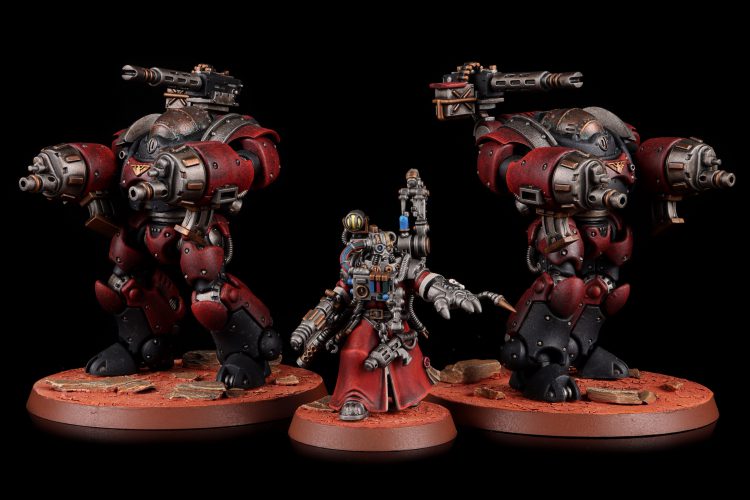
Credit: Pendulin
Cybernetica Datasmith – the first Action Hero
Datasmiths are the second example of a unit with an action on their data sheet in the game, but the first one that most people will care about because the unit it affects is actually decent.
Field Reprogramming (Action): At the end of your Movement Phase, any number of CYBERNETICA DATASMITH models from your army can start to perform this action. When the action is started, select one friendly <FORGE WORLD> KASTELAN ROBOTS unit within 6” of the model performing the action and one of the available protocols found on that unit’s datasheet. The action is completed at the end of your next Command phase. When it is completed, the selected protocol replaces that unit’s active protocol.
This has some interaction with the rest of the data sheet, specifically that Auras character models have are disabled when completing an action.
A CHARACTER unit cannot use any aura abilities while it is performing an action (if the action is failed, their aura abilities immediately take effect again).
So while the Datasmith is reprogramming the Kastelan the Datasmith Aura that provides them with the CORE keyword is disabled. They do have another ability that allows them to repair Kastelans during the movement phase which continues to be available during the action being performed.
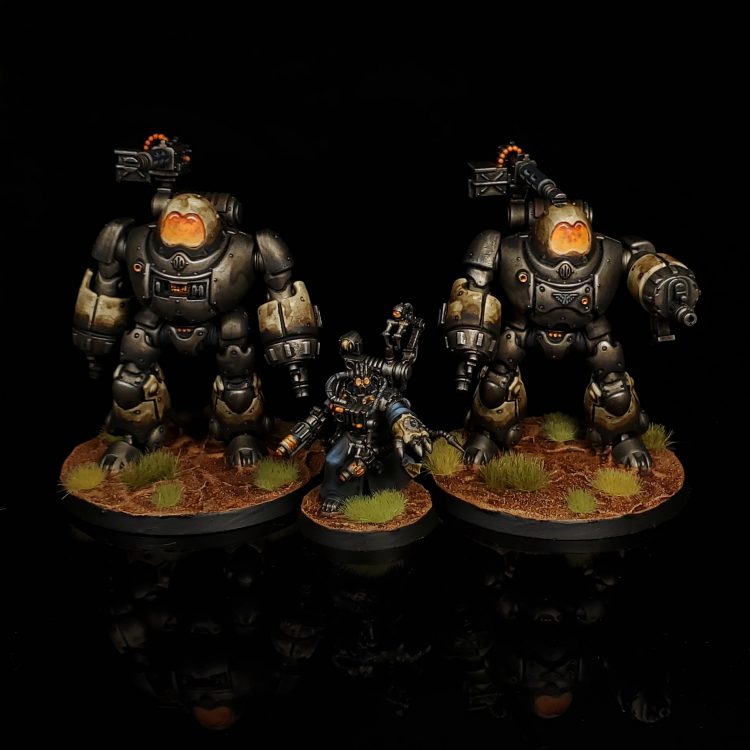
If a unit was CORE when I used an ability on it and it’s not CORE now, does the effect still apply?
For instance Cawl is going to use Lord of Mars on a unit of Kastelan Robots, the Robots are currently CORE because they are within 3” of a Cybernettica Datasmith.
Lord of Mars: In your Command Phase, select one friendly MARS CORE unit within 6” of this model. Until the start of your next Command Phase, each time a model in that unit makes an attack, you can re-roll the hit roll.
Now this ability is not an aura and creates an effect that lasts until a specific time. So long as the Kastelans were a valid pick during the command phase then if they lose core later on by moving away from the Datasmith then the effect continues.
Wings: Be aware, however, that during the turn after you start the Action, your Datasmith won’t finish their Action, and thus regain their Aura, until the end of your Command Phase, meaning that on that turn you won’t be able to apply any “in your Command Phase” effects that rely on CORE.
Chaff Launchers and the Lucius Dogma vs a 2 Damage weapon.
So you’ve just been attacked by a 2 damage weapon, and Chaff Launchers have reduced the damage to 1. Does the Lucius dogma apply to this attack? I think the answer is no, a little frustratingly in my opinion, as we have a Rare Rule for defensive abilities and the characteristics they are triggered by, which for AP is meant to be the modified value.
DEFENSIVE RULES THAT APPLY TO ATTACKS WITH SPECIFIC CHARACTERISTICS
Some rules only apply against attacks that have a specific characteristic. For example, ‘Each time an attack with an Armour Penetration characteristic of -1 is allocated to a model in this unit, that attack has an Armour Penetration characteristic of 0 instead.’ Each time you determine if such a rule is triggered, and so applies, always use the modified characteristics of that attack at the Allocate Attack step of the attack sequence. In the example above, that means that if an attack which originally has an Armour Penetration characteristic of 0, but then is modified by another rule before the Allocate Attack step to be -1, then at the Allocate Attack step it would then trigger the ability and be changed back to 0 instead.
This doesn’t apply here though because both Chaff Launchers and the Lucius Dogma happen when “an attack of [specific characteristic] is allocated to a model”; they are modifying it after/during being allocated and not before, as the rule requires. So if shot by a 2 damage weapon Chaff would trigger, it’d become 1 Damage but Lucius wouldn’t apply as when it was allocated it was still 2 Damage. Simple right?
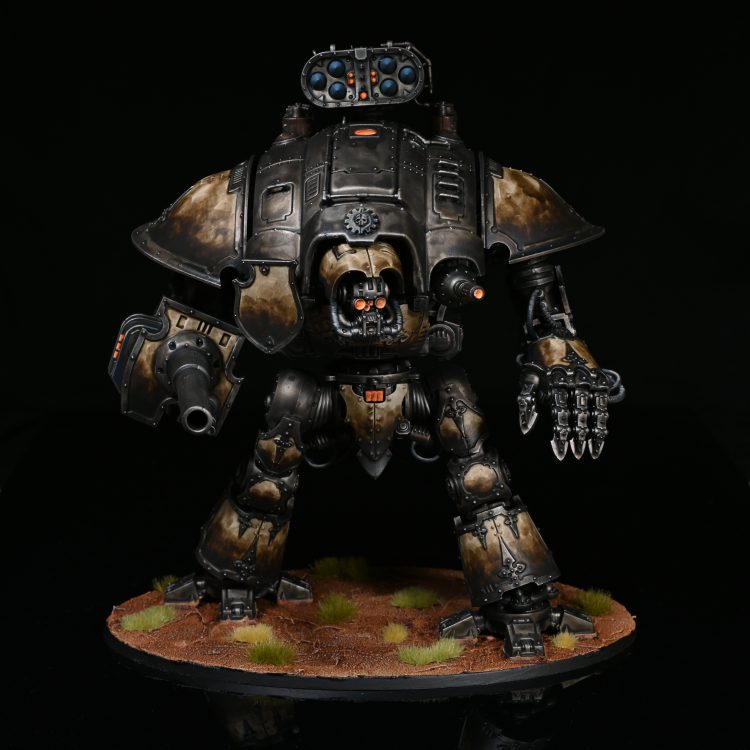
How the heck does Knights of the Cog work and the Book of Rust Stratagem?
I’ve asked for an Admech expert to explain this one because on a first read it seemed fiddly or broken or somewhere between.
Q: My Admech army has a Metalica Battalion Detachment as well as a Raven Imperial Knight Super-heavy Detachment with three units of knights. I use the Knight of the Iron Cog strategem three times before the game begins: once on each unit of Imperial Knights. When the game starts, do my Skitarii gain their Doctrinas? Do my Cult Mechanicus or my Imperial Knights gain Canticles?
– Confused in Charadon
Pendulin: Right you are to be confused, because there’s a lot to unpack here. First off, let’s look at some relevant rules:
DOCTRINA IMPERATIVES / CANTICLES OF THE OMNISSIAH
If every unit from your army has the ADEPTUS MECHANICUS keyword (excluding AGENT OF THE IMPERIUM, UNALIGNED, and KNIGHT OF THE COG units) this unit […]
Both Doctrinas and Canticles begin with identical phrasing, requiring each unit in your army to have at least one of those four keywords. If that condition is met, then your Admech are affected by the active Doctrinas and Canticles as you’d expect (the units technically still have the ability either way but it doesn’t actually do anything unless the army meets those keyword requirements). But what about that Knight of the Cog keyword, where does that come from? Let’s look at the Knight of the Cog detachment ability that each Admech detachment has.
KNIGHT OF THE COG
For each Detachment in your army with this ability, you can select on QUESTOR MECHANICUS Super-heavy Auxiliary Detachment in your army. Models in that Detachment gain the KNIGHT OF THE COG keyword.
If you take one Admech Battalion Detachment and one Imperial Knight Super-heavy Auxiliary Detachment, then that single Imperial Knight unit gains the Knight of the Cog keyword if they are from a Questor Mechanicus household. This means your Skitarii get Doctrina Imperative effects and Cult Mechanicus get Canticle effects. If you have two Imperial Knight Super-heavy Auxiliary Detachments, then you’d need two Admech detachments in order to keep Canticles/Doctrinas active (meaning it’s out of scope for Strike Force games).
But the question was about a Super-heavy Detachment, not a Super-heavy Auxiliary Detachment. So what happens if you take an Imperial Knight Super-heavy Detachment and an Admech Battalion Detachment? Well, your Knight of the Cog ability doesn’t kick in. This means everyone loses their Doctrinas and Canticles. Unless …
Let’s keep peeling this onion. If your Admech Battalion Detachment is from Forge World Metalica, then you have access to a set of stratagems from War Zone Charadon Act 1: Book of Rust. One of these stratagems is Knight of the Irons Cog (not to be confused with the similarly named Knight of the Cog), emphasis mine:
KNIGHT OF THE IRON COG
Use this Stratagem before the battle, when you are mustering your army. Select one HOUSE RAVEN unit from your army. That unit gains the Canticles of the Omnissiah ability and is considered to have the ADEPTUS MECHANICUS keyword for the purposes of this ability (the inclusion of this unit in your army does not prevent ADEPTUS MECHANICUS units in your army from using any rules that require every model in your army to have the ADEPTUS MECHANICUS keyword).
There’s no limit on the number of times you can perform this Stratagem, so you can use it on each unit of Imperial Knights in your Super-heavy Detachment. While this Stratagem doesn’t give those knights the Knight of the Cog keyword, it does explicitly state the inclusion of these knights does not prevent your Admech “from using any rules that require every model in your army” to be Admech. This means if all knight units have been Knight of the Iron Cog’d, then their inclusion in your army does not prevent your Skitarii from gaining Doctrinas, nor does it prevent your Cult Mechanicus from gaining Canticles. Additionally, each of those Imperial Knights also gain Canticles.
In summary, there are two ways to include Imperial Knights in an Admech army without breaking Doctrinas and Canticles:
- Knight of the Cog: For each Admech detachment in your army, you may include a single Imperial Knight Super-heavy Auxiliary Detachment. The presence of Imperial Knights in these Super-heavy Auxility detachments do not affect Doctrinas or Canticles.
- Knight of the Iron Cog: If you have a Metalica Admech detachment, you may include any number of Imperial Knights in Super-heavy Detachments. If you do this, then you must you use the Knight of the Iron Cog strategem on each of those Imperial Knights in order for Doctrinas and Canticles to remain functional.
And since I’ve got the floor, I’m also going to look at one of our new Ruststalker abilities.
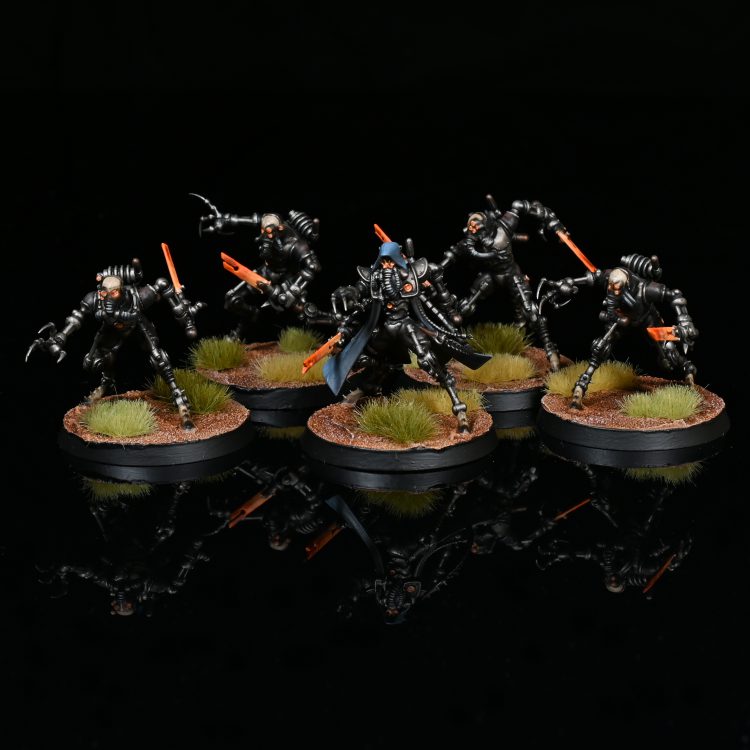
Are Ruststalkers immune to Difficult Ground?
Ruststalkers have the Optimised Gait ability:
OPTIMISED GAIT
This unit can ignore any or all modifiers to its Move characteristic, with the exception of that incurred due to the Deprecation effect of the Bulwark Imperative (pg 85). This unit can ignore any or all modifiers to its Advance rolls and charge rolls.
Previously this ability would not have ignored Difficult ground because the original wording of that rule didn’t modify the move characteristic, advance rolls or charge rolls. The new rule does modify them though.
Difficult Ground
If a unit makes a Normal Move, Advances or Falls Back, and any of its models wish to move over any part of this terrain feature, subtract 2″ from the Move characteristic of every model in that unit (to a minimum of 0), even if every part of this terrain feature is 1″ or less in height. If a unit declares a charge, and any of its models wish to move over any part of this terrain feature as part of its subsequent charge move, subtract 2 from that unit’s charge roll, even if every part of this terrain feature is 1″ or less in height. These modifiers do not apply if every model in the moving unit can Fly. These modifiers do not apply if every model in the moving unit is Titanic and this terrain feature is less than 3″ in height. The height of a terrain feature is measured from the highest point on that terrain feature.’
So Optimised Gait can now ignore the effects of Difficult Ground, something that also gives a nice helping hand to Death Guard over in Chaos land.
GW FAQed!
Admech Transports can carry what now?
The FAQ has amended the entry for the Dunerider and Transvector to just say <FORGEWORLD> INFANTRY.
Page 108 – Skorpius Dunerider, Transport Change to: ‘This model has a transport capacity of 12 Infantry models.’
Page 109 – Archaeopter Transvector, Transport Change to: ‘This model has a transport capacity of 6 Infantry models.’
Previous Answer
Admech – Enriched Rounds vs BS Modifying Abilities
Q: A unit of Skitarii Vanguard shoots at a Culexus assassin, and thus has BS6+. They then use their stratagem to automatically wound on hit rolls of a 4+. What happens to hit rolls of 4 and 5? Do they miss? Hit? Automatically wound?
Note: This stratagem has since changed to a 5+ trigger but the rest of the answer is still partially relevant.
First let’s check the wording of the Stratagem,
Use this Stratagem in your Shooting phase, when an ADEPTUS MECHANICUS unit from your army is selected to shoot. Until the end of the phase, each time a model in that unit makes an attack with a radium weapon against an enemy unit (excluding VEHICLE units), an unmodified hit roll of 4+ automatically wounds the target.
So essentially against the BS6+ rule the 4s, 5s and 6s, would just be wounds. The stratagem doesn’t require the attacks to hit for its effect to apply. In fact in normal usage the unit can be buffed as high as hitting on 2+, so when using this stratagem there’s not the just the auto wounds but the hits they’d normally score on 2s and 3s to still roll normal wounds for.
UPDATE on Feedback
I thought this was pretty cut and dry but some very helpful comments have convinced me to take a second look at this. I’m not a 100% that it’s clear but I agree with the logic I’ve been presented with. The issue is with the hit roll rules themselves.
When a model makes an attack, make one hit roll for that attack by rolling one D6. If the result of the hit roll is equal to or greater than the attacking model’s Ballistic Skill (BS) characteristic (if the attack is being made with a ranged weapon) or its Weapon Skill (WS) characteristic (if the attack is being made with a melee weapon), then that attack scores one hit against the target unit. If not, the attack fails and the attack sequence ends.
So a roll of 4 or 5 to hit with an Enriched Round “automatically wounds” but the rules aren’t clear on if this means it “has wounded” or if it’s “going to automatically pass the wound roll”. I’m inclined on further reading to lean towards the latter. Meaning that you’d actually need to hit in order to advance to this step of the sequence, at which point you would then automatically wound. This does change a few other facets of the rule in common usage, for instance in the turn that the unit BS is reduced to 4+ by an imperative, then if the unit Advanced, shot through dense cover, or was affected by some other -1 to hit penalty. They’d only be hitting on 5s.
I think this interaction probably requires an FAQ to be sure, but until then (or a new Admech codex perhaps) I think it best to talk this interaction out pregame to be sure which interpretation is being used.
Have any questions or feedback? Got a rules question you want answered? Drop us a note in the comments below, ask a question in our Ruleshammer form, or head over to r/ruleshammer to discuss.
